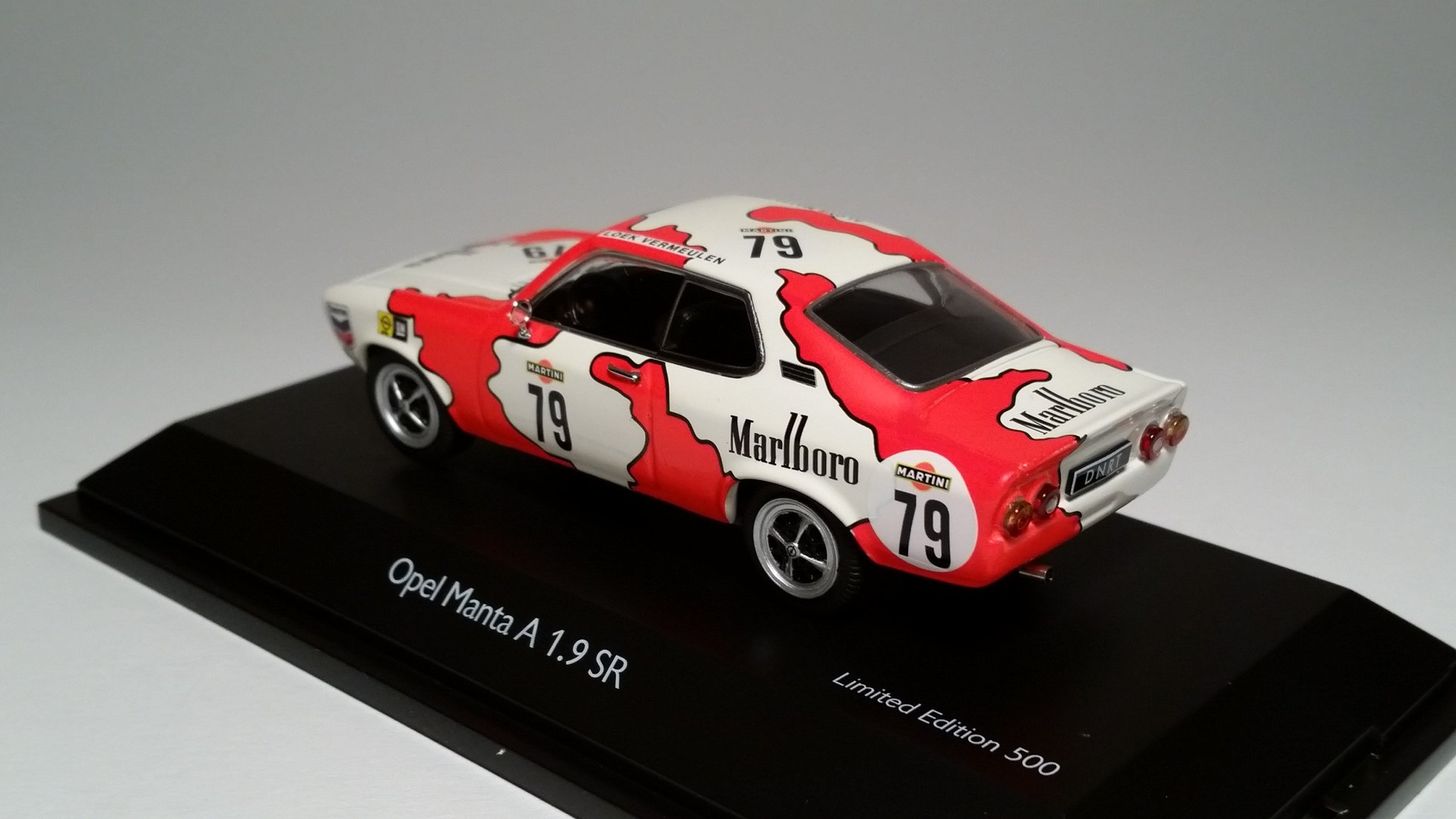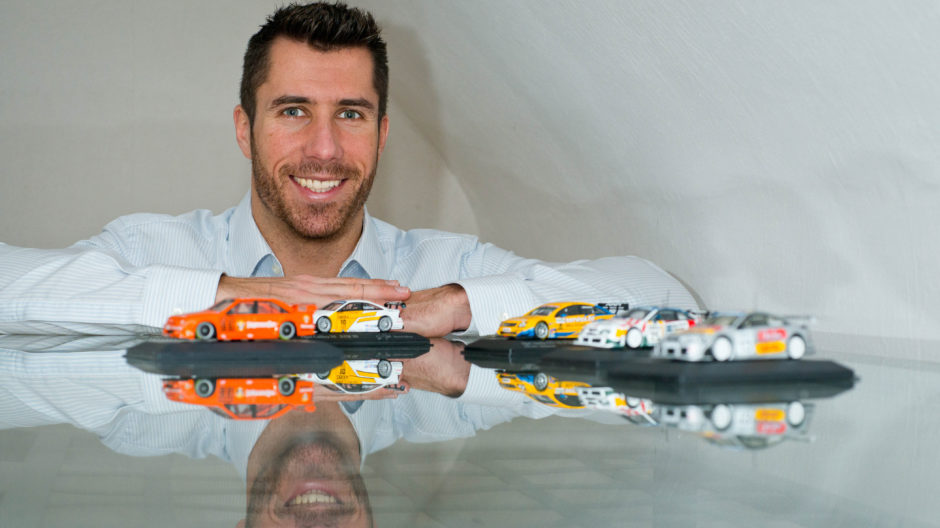- Stolzer Sammler: Markus Sabais vor einem Teil seiner Kollektion.
- DTM 2005, Manuel Reuter (12), Vectra GTS, Team OPC. Minichamps 400054612.
- DTM 2005, Manuel Reuter (12) Vectra GTS V8, Team OPC. Zandvoort 28.08.05, 200stes DTM-Rennen. Minichamps 436054612.
- Neben den Modellen präsentiert der Sammler im Netz auch Geschichten, Autogrammkarten und originalgetreue Nachbildungen der Helme.
- Keke Rosberg (FIN), Helm, Maßstab 1:8. Minichamps 385954192.
- 24-Stunden-Rennen Spa-Francorchamps, 1973, Loek Vermeulen und Alois Matthijssen (79), Manta A, Dutch Marlboro Racing. Schuco 450344500.
- World Rallye Championship (WRC) 1974 Korsika, Jean-Louis Barailler und Joseph Pantalacci (28), Team BP Opel Marseille, Commodore B. Schuco 450277200.
- DTM 1995, K. Ludwig u. K. Rosberg, Calibra V6, Team Rosberg, Werbemodell der Spielwarenmesse. Minichamps.
- Olympia Rallye 1972, Henri Gréder und Christian Delferrier (12), Gréder Racing, Ascona 1.9 SR. Schuco 2659.
- DTM 1996, Hans-Joachim Stuck (44), Calibra V6, Team Rosberg, Helsinki 09.06.96. Minichamps 430964244.
The pieces presented inside the glass display cases sparkle and shine. Neatly arranged and beautifully lit, this fleet of model touring cars documents the motor racing history of an entire era. The origins of the collection date back to the mid-1990s, starting with Manuel Reuter’s 1995 DTM Calibra. Today, Markus Sabais’ display cases house around 210 model cars, all of them at a scale of 1:43 and mostly representing the DTM, ITC, STW, and VLN series, as well as the 24-hour races. The models are fully documented in a catalog, and they are also available to the public online at www.lightningmodels.de.
IT ALL STARTED IN BELGIUM
Markus Sabais (35) found his passion for motor racing through his father. “My dad was a test driver for the Vehicle Development department at Opel,” recounts Sabais. “One time, he let me come along in his Omega 3000 to a DTM race in Zolder.” This set several things in motion for young Markus. “The fire-red Omega with its roaring six-cylinder engine was a pre-production model, and I knew this was something very special. The race itself completely blew me away, as well,” remembers Sabais. Along with an enduring love for motor racing, the experience also sparked his passion for model cars, which has been with him ever since.

24 hours Spa-Francorchamps, 1973, Loek Vermeulen und Alois Matthijssen (79), Manta A, Dutch Marlboro Racing. Schuco 450344500.
Containing 210 different Opel racing cars, Sabais’ collection – housed at his home in Nauheim near Gross-Gerau – is one of the most impressive of its kind. His fleet of model cars grew gradually, with new additions mostly coming from Internet traders or from model car exchanges such as ‘Carmania,’ which is held twice a year at the Opel plant. Attended by many seasoned collectors, this model car fair is a great place to unearth rare gems. Some of the sought-after items are obscure models that were only released in very limited runs. Others, which are even more precious, are models that were never mass-produced at all and that expert collectors have customized themselves. “Some racing cars – each of which has its own individual configuration of wheels, labels, and antennas – were only ever used for a single race, or in some rare cases, only for a single training session.” As a labor of love, the more adept among the collectors’ community would therefore take standard mass-produced models and carefully modify them in order to replicate these unique racing cars.
»
You can literally feel the passion and dedication of this collector, he is obviously very committed to the brand and also to motor racing as a whole. It’s really happening here.
»Alex«
feedback section of the website
www.lightningmodels.de
STRINGENT DEMANDS ON EVERY MODEL
Because most models are no longer available through retailers, many need to be sourced second-hand. The quality differences can be staggering, and buying a model from an Internet seller can end up wasting more time than inspecting it in the flesh. “Attention to detail is vital to me,” says Sabais. “Even if just one of the text labels is skewed, damaged, or missing altogether, the model is rendered basically worthless.”
When it comes to sourcing the rarer pieces of the collection, then, Sabais sometimes needs to part with hefty amounts of cash. Mass-produced model cars of this kind typically cost between €10 and €55, and one-off versions usually sell for quite a bit more. In terms of pure expenditure, Sabais’ collection is a substantial investment in itself. In terms of sentimental value, of course, it is worth a lot more than just the money spent. For Sabais, this hinges on two main factors: “On the one hand, there are certain models that I came across at some point and decided that they were vital to my collection.” In cases like this, he conducts extensive research online and talks to other collectors at model car fairs, and eventually, he’ll locate the objects of his desire. “The other thing that keeps me going with this collection is how unique it is – I simply love it,” says Sabais. That’s also why he can’t help himself but show off his model cars on his website.
»
Hey, this must be one of the coolest and best designed websites I’ve ever come across. Amazing photos, and I love all the background info. Great job.
»Volker«
feedback section of the website
www.lightningmodels.de
MORE THAN JUST MODEL CARS
“My aim isn’t just to collect and show off rare and special models. I also want to share stories and anecdotes to do with Opel’s motor racing history. Quite a few of these are included on my website,” says Sabais. The paraphernalia also includes numerous autographs from stars of the touring car racing circuit, such as Timo Glock, Roland Asch, Frank Biela, Peter Dumbreck, Bernd Schneider, Matthias Eckström, and Johnny Cecotto, as well as earlier Formula One drivers such as Giancarlo Fisichella and Keke Rosberg. What’s more, Sabais even has highly authentic model replicas of some of the drivers’ helmets.

DTM 2000, Eric Hélary (11), Astra V8 Coupé, Team Holzer. Minichamps 430004811.
Unsurprisingly, the feedback section of the website is full of praise. “I’ve hardly ever seen such an exhaustive documentation of this great carmaker’s motor racing history – it’s simply amazing. You can literally feel the passion and dedication of this collector, he is obviously very committed to the brand and also to motor racing as a whole. It’s really happening here,” writes Alex. “Hey, this must be one of the coolest and best designed websites I’ve ever come across. Amazing photos, and I love all the background info. Great job,” writes Volker.
BEGINNINGS OF A SECOND COLLECTION
Sabais, whose day job is with the police in Frankfurt, knows that his collection of Opel touring cars is about as perfect as it can humanly get. Not one to rest on his laurels, he is now delving into other chapters of the carmaker’s motor racing history. For example, there is a venerable tradition of Formula racing cars being produced in Rüsselsheim, starting with the high-performance engines built for Formula Junior through Formula 3 vehicles. Then there are the rally races; in the German and international championships, models such as the Ascona B 400 and the Kadett GTE were known to provide fierce competition, and they’d often be one of the first to cross the finish line. For a collector, this is an exciting area to dive into, and if Sabais were to be as comprehensive here as in the area of touring car racing, viewers could gain a lot of interesting insights. After all, who actually still remembers that Walter Röhrl’s 1982 World Rally Championship victory was won not with a Porsche or Audi but a humble Opel Ascona 400?
Model cars come in surprisingly many different scales. Although the 1:43-scale plastic models from Markus Sabais’ collection are among the most common to be encountered in this field, many collections also include significantly larger and smaller model cars. At a size of 1:87, the more minute of the replicas are usually presented either in display cases or on the roads of model railway sets. Accordingly, their size is also described as ‘H0’ in keeping with model railway nomenclature.
The models collected by Sabais, in contrast, have a size of ‘H’; other collections might also include scale sizes of 1:12 or 1:8, as well as tiny replicas with scales as low as 1:120 or even 1:160.
Well known model car companies include Minichamps, Revell, Bburago, and Hot Wheels. The classic Matchbox cars, which have a scale of 1:64 and are generally sold as children’s toys, are today largely made by Siku and Majorette, as well as of course Matchbox itself.
The smaller-scale 1:87 models are mostly produced by Herpa and Wiking and are generally made from plastic. The models from Schuco are an exception here; dating back to the 1950s, this manufacturer’s model cars have always been made from die-cast metal.
Almost every time Opel updates its life-sized car models, it gets the modelcraft makers to produce replicas that mirror the changes as faithfully as possible. To this end, the manufacturers are frequently provided with digital copies of Opel’s original design drawings and specifications for the models in question.










